The fish tank was back. The same week that the huge colorful aquarium was returned to its place in the waiting room of the UNM Cancer Center, Ellen Reavis left this world for a new adventure. Ellen didn’t know that in a life of both big and little causes, she was the victor in her last skirmish – the fish tank was back.
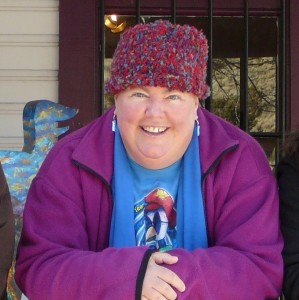
Ellen was a regular at the Cancer Center. Everyone knew her as the Jolly Buddha, dressed in either tie-dyed or exotic Hawaiian shirts. She had the largest repertoire of hats to cover her pink bald head. When her hair started to grow back, baby fine, she dyed it bright red.
Ellen was only forty-eight when, coming out of anesthesia from a routine procedure, she was told that she had endometrial cancer. Days later, a CT scan showed “tumors too numerous to count” in her lungs and liver. The macabre joke was oft told: “Ellen’s lungs look like she’s been hunting with Dick Cheney.”
Although in shock, Ellen and her partner of fifteen years, Ruth Hanckel, did the right thing – they researched treatment centers, interviewed oncologists, became neophyte experts on the disease and its treatment. They chose Dr. Carolyn Y. Muller, a nationally known expert in the treatment of gynecological cancers, and the UNM Cancer Center, one of the best cancer treatment centers in the nation.
Ellen was immediately admitted to a promising Phase Three Study, using a new combination of chemotherapies. She, however, was assigned to the half of the trial that was administered a standard accepted chemotherapy drug. Ellen’s early response was very favorable. Having successfully negotiated the first hurdles in what Ellen called her “thirty-year plan”, she came to a wall: An MRI of her brain showed eight small tumors, each the size of a Cheerio. To scale the wall she had to stop the chemo drugs and start a course of full-brain radiation with Dr. Gene Wong. The radiation was successful, but the resumed chemotherapy never worked as well as it had in the beginning. Her thoracic and abdominal lymph nodes started to grow larger.
Ellen and Ruth were not alone in the horrible first months. They had hundreds of friends. Ruth worked at Eclipse Aviation. Her bosses gave her all the flexibility she needed in her schedule. Ellen had long been an advocate in many fields – labor and employment, legislative, the women’s community, autism and children with special needs – she had colleagues and friends throughout the state.
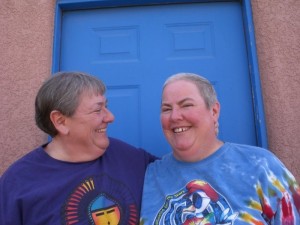
As an Occupational Therapist (OT) for the Albuquerque Public Schools (APS), Ellen worked with all types of special needs children, but her specialty was with those with autism. In 2006, she was named to the APS Autism Services team to facilitate the training of OTs and Physical Therapists (PTs) to better meet the needs of kids who fell into the autism spectrum of diseases. She emphasized family involvement. She was innovative. One colleague remembers the day that Ellen, frustrated with the pinching behavior of one of her small clients, wrapped herself in foam rubber and duct tape, solving the immediate problem to hilarious effect.
Sidney Alley, Lead Therapist at APS, described her best, “Ellen Reavis was a force of nature in her steadfast dedication to students with special needs, but also in her support of families and educational staff that are so integral to the success of students with differences. In her typical Hawaiian shirt attire and accompanying energy, Ellen had a gift for entertaining us but also for embracing the causes of families and communities affected by autism. She showed us all how individual voices could work in unison and create opportunities that better the lives of so many of our children. Anyone who ever worked with Ellen on a project knew that she would not give up until she was satisfied with the outcome; she would step back and look at a task from every possible angle and ensure that she had addressed potential challenges or obstacles. Friends poked fun at the degree of her persistence and would often feign an attempt to hide from her because they knew she would challenge them to delve deeper into the task. She took the teasing in typical good humor and then she continued to keep us all on track with the important work at hand.”
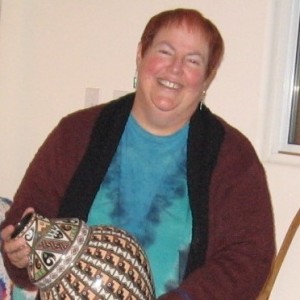
As a past president of the New Mexico Autism Society, Ellen advocated for the rights, treatment, and support of both children and adults with diseases in the autism spectrum.
Ellen also advocated for her colleagues. For years, she lobbied the state legislature for the rights of OTs and Physical Therapists (PTs) to receive fair pay and working conditions. She won that fight in August 2006. Vicki Putman, a social worker in the Santa Fe Public Schools, who was working on the same issues, said, Ellen “was a truly unique individual. She was like a fast moving train that picked up other train cars and took us along with her toward her destination. She never faltered, she knew what was right and got us all fired up.”
In January 2007, Ellen was back at the Roundhouse fighting for Senator Dede Feldman’s Senate Bill 164 for autism funding – the first autism service package for New Mexico. The Senate honored Ellen with an official commemoration in early April.
Although Ellen was forced to leave her job due to the heavy cancer treatment schedule, the muscle wasting effect of the chemo, and fear for her compromised immune system, she created a new life. She fought with her treatment team about a prohibition on travel – they feared that she would contract a life-threatening infection. She went to New Orleans, visited family in Michigan and Washington, and took two weeks in Mexico. (Dr. Muller warned her about the extreme danger of sea coral cuts, so Ellen sent back photos of hang-gliders over the ocean, asserting that she was keeping far away from submerged coral.)
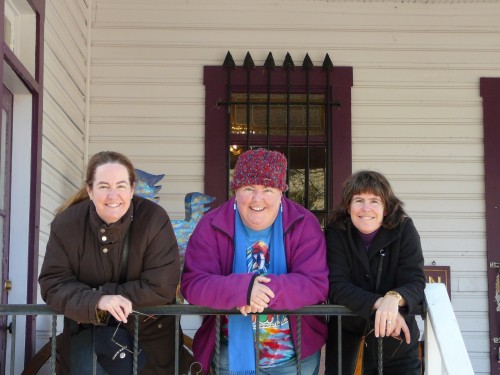
To stay in touch with children with the varied conditions in the autism spectrum of diseases, Ellen volunteered at Camp Rising Sun last summer as well as at the Wheelchair Sports Camp. She didn’t have unlimited energy, so she was the photographer. More importantly, she was a knowledgeable resource for the therapists and volunteers. Sharon Cruse, a counselor at Camp Rising Sun, said, “She was wonderful with the kids. More wonderful was to see how the young counselors watched and learned from Ellen. ‘The Passing of the Torch’ was just an expression to me until I watched Ellen share her love and talent with the counselors and kids at Camp Rising Sun.”
“Fun” was a word that figured in Ellen’s conversation every day. A month after she started chemotherapy, Ruth and Ellen donated to the Cibola Choral Boosters, who “flocked” Dr. Muller’s lawn. “Flocking” is a practice where 140 pink plastic flamingos appear anonymously on the victim’s property, only to disappear again twenty-four hours later. This event became the talk of the Cancer Center. Although, they never took credit, Ellen and Ruth held the threat of “flocking” over the more reserved Dr. Wong’s head for months. He started seeing flamingo references at every turn.
When the traditional chemotherapy ceased to be effective after five months, Ellen volunteered for a Phase One study, but the therapy was not effective in slowing the progression of Ellen’s cancer. She wrote an article for the New Mexico Cancer care Alliance newsletter, entitled Rolling the Dice, about the experience.
Ellen chose her oncologist, Carolyn Muller, both because she specialized in gynecological cancers and because of her reputation in the field, but also because Dr. Muller had written an article in a professional journal called “The Miracle of Life and the Privilege of Death.” In the article, addressed to colleagues, Dr. Muller argued that as much attention should be paid to helping a patient die as to vigorously fighting to keep them alive.
The end came fast. In January, Ellen fought her last battle – the crusade for the fish tank. One day, workmen came to take the tank away. No one could explain to Ellen’s satisfaction why that happened or whether the aquarium would be returned. Ellen, always proactive, grabbed a piece of paper, wrote up a petition and made ten copies. It read: “Please bring our fish aquarium back. We watch the fish when we are anxious or angry or just plain bored. It’s an important part of our waiting room.” Everyone signed – patients, family members, doctors, nurses, secretaries, technicians, and even members of the Cancer Center’s administration.
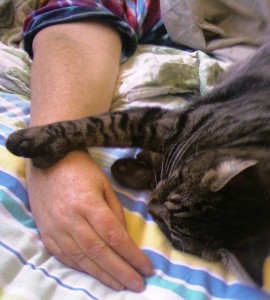
By early February, Ellen knew something was seriously wrong. She had just started a new Phase One study and she was experiencing severe muscle weakness and confusion. “I’m not in touch with my brain,” she said. The next CT scan and blood tumor-marker test told the story. Her cancer had increased ten-fold in two months. She was soon unable to get out of bed without help.
Her colleagues and friends rallied around. Over fifty OTs, PTs, social workers, speech therapists and teachers from APS volunteered to sit at her bedside, each for a two-hour shift. Ellen was never alone. Ten to twenty people a day, sitting with Ellen or in the living room, sharing stories, laughter and tears.
Ellen died in her sleep at home on February 28. She was buried in a handcrafted pine box covered with the messages of her friends and family. She rests in a 150-year-old San Jose de Armijo Cemetery on the 300-year-old Atrisco Land Grant.
Sometime in the last week of February the aquarium was reinstalled in the patients’ and families’ waiting room of the UNM Cancer Center. Soon it will bear a plaque honoring Ellen.
A Celebration of the Life of Ellen Reavis took place on April 18.
